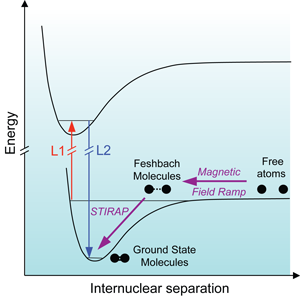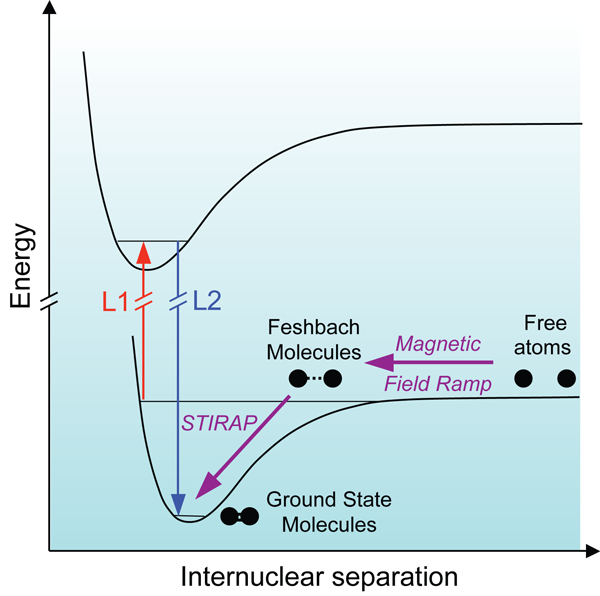From atoms to molecules (and back)
The quest for the creation of ultracold and quantum degenerate molecular gases is currently of paramount interest within the atomic and molecular physics and physical chemistry communities. The richness of molecular physics coupled with the remarkable control afforded by ultracold systems offers enormous scope for applications in fields ranging from precision measurement and high-resolution spectroscopy [1–3] to ultracold chemistry [4] and quantum information processing [5]. Now, F. Lang, K. Winkler, C. Strauss, R. Grimm, and J. Hecker Denschlag at the University of Innsbruck report in Physical Review Letters their successful creation of an ultracold gas of ground-state Rb2 molecules close to quantum degeneracy [6]. In the same issue, J. Deiglmayr, A. Grochola, M. Repp, K. Mörtlbauer, C. Glück, J. Lange, O. Dulieu, R. Wester, and M. Weidemüller at the University of Freiburg report formation of ultracold LiCs molecules [7], and recently researchers at JILA have reported creating ultracold KRb molecules [8]. These results herald a new era for experiments in cold quantum matter.
The advent of laser cooling revolutionized atomic physics and precipitated the realization of quantum degenerate gases in the form of Bose-Einstein condensates (BEC) and Fermi-degenerate gases. These dilute atomic gases have proved surprisingly rich and are now routinely studied throughout the world. However, the laser cooling techniques at the heart of all these experiments do not work for molecules due to their complex internal rotational and vibrational structure. This prompted an exciting race to develop an alternative approach to create ultracold molecular gases with a wide range of techniques being pursued, including Stark deceleration, buffer gas cooling, electrostatic velocity selection, optical Stark deceleration, Zeeman deceleration, and collisional cooling in crossed molecular beams [9]. Recently, however, researchers have managed to exploit the huge advances in laser cooling, trapping, and manipulation of atomic gases by carefully assembling molecules from ultracold atoms.
Two atoms can be fused together to form a molecule through the absorption of a photon from an applied laser field during an atomic collision—a process known as photoassociation [10]. In this case, however, the molecule is electronically excited and will subsequently decay either back to a pair of free atoms or to a ground-state molecule (for bi-alkali molecules the bound states are described by a singlet and a triplet potential, with the singlet potential being typically an order of magnitude deeper). The downward decay process generally leads to a range of ground rovibrational states being populated (rovibrational states correspond to simultaneous rotation and vibration of the molecule). In more elaborate approaches a second photon of different energy can be used to steer the downward step in a “pump-dump” scheme. Application of these schemes to atoms held in a magneto-optical trap can produce tightly bound ultracold molecules [11], although the production rate is often low and the state selectivity can be poor. Nevertheless, recent advances in this field have produced molecules in the absolute (singlet) rovibrational ground state in a variety of atomic gases [7,12,13].
Over the last five years, the quantum degenerate gas community has mastered an alternative technique to associate atoms into molecules. The approach relies upon the existence of scattering resonances in the collisions between ultracold atoms that result from a coupling between the free atoms and a quasibound molecular state known as a Feshbach resonance. The simple application of an appropriate magnetic field ramp in the vicinity of a Feshbach resonance results in the highly efficient conversion of atoms to molecules whilst preserving the phase-space density of the original atomic sample [14]. The creation of such Feshbach molecules proved an exciting milestone and has been at the heart of many recent advances in the field. However, Feshbach molecules can be extremely fragile—existing in very weakly bound states close to the dissociation threshold they are generally unstable when colliding with each other.
The key to the success of the experiment by Lang et al. is to combine optical transfer techniques with the production of Feshbach molecules. Starting from an atomic 87Rb Bose-Einstein condensate they create a pure sample of Rb2 Feshbach molecules using a resonance at a magnetic field of around 1000G. The magic of their experiment is then to coherently transfer the Feshbach molecules to a single quantum level in the rovibrational ground state of the triplet potential. The technique they use is known as stimulated Raman adiabatic passage or STIRAP [15] and requires the application of two laser fields that couple the initial and final molecular states to a common electronically excited state (Fig. 1). In essence, STIRAP converts the initial Feshbach molecular state into the final ground molecular state upon the application of the appropriate sequence of laser pulses. The technique can be extremely efficient (Lang et al. report about 90% efficiency) and crucially avoids populating the short-lived excited state thereby reducing losses due to spontaneous emission.
STIRAP was first applied to Feshbach molecules by the Innsbruck group almost two years ago. In a proof of principle experiment [16] they coherently transferred the Feshbach molecule to the second-to-last bound vibrational level, increasing the molecular binding energy to around 600MHz×h (roughly just 0.01% of the depth of the triplet potential). Then earlier this year a group led by Deborah Jin and Jun Ye at JILA in Colorado applied the same technique to heteronuclear Feshbach molecules created in a mixed atomic gas of 40K and 87Rb to increase the binding energy by more than 10GHz×h [17]. Shortly afterwards, Hanns-Christoph Nägerl and co-workers, also at the University of Innsbruck, reported a major breakthrough [18]. They converted Cs2 Feshbach molecules to tightly bound molecules bound by more than 1000 wave numbers (1 wave number is roughly 30GHz) corresponding to around 30% of the depth of the singlet potential. Now Lang et al. have transferred molecules to the absolute lowest quantum state of the triplet potential and similar results have been reported by the JILA group for both singlet and triplet KRb molecules [8].
In all of these experiments the molecular fraction is detected by simply repeating the STIRAP process in reverse and then dissociating the Feshbach molecules. This is the beauty of the STIRAP-Feshbach molecule approach—one can coherently couple from atoms to molecules and back without significantly heating the sample. This allows sensitive atomic imaging techniques to be used to indirectly probe the molecular fraction, negating the need for complicated detection schemes based upon photoionisation. Lang et al. performed their experiment in a 3D optical lattice formed by the interference of several laser beams. They demonstrate that not only does the lattice confine a sizeable fraction of the molecules, but also that the dynamics of the molecules in the lattice potential are also detectable. This reveals that both the internal and external degrees of freedom of the molecules are precisely defined after the transfer and illustrates the exquisite control with which we are now able to manipulate ultracold quantum systems.
Clearly this is a very exciting time in the race to produce degenerate molecular gases, but where do we go next? Already the production of ground-state triplet molecules provides a new arena for studies of ultracold collision processes central to the study of ultracold chemistry [4]. There is an immediate need to extend the transfer process to the absolute singlet ground state of the molecule, which is intrinsically stable when undergoing cold collisions. This stability should allow the formation of long-lived molecular Bose-Einstein condensates. The extension of the technique to other species is similarly important. In particular, there is great interest in the production of heteronuclear ground-state molecules, which would open the door to the world of strongly interacting dipolar quantum gases. Great strides in this direction have already been made by the JILA group [8]. It remains a great challenge, of course, to cool and trap more complex molecules. Nevertheless, Lang et al. and Deiglmayer et al. demonstrate that we are perfecting the tools to master the control of quantum systems to the level required to meet these challenges head on.
References
- J. J. Hudson, B. E. Sauer, M. R. Tarbutt, and E. A. Hinds, Phys. Rev. Lett. 89, 023003 (2002)
- T. Zelevinsky, S. Kotochigova, and J. Ye, Phys. Rev. Lett. 100, 043201 (2008)
- D. DeMille, S. Sainis, J. Sage, T. Bergeman, S. Kotochigova, and E. Tiesinga, Phys. Rev. Lett. 100, 043202 (2008)
- R. V. Krems, Int. Rev. Phys. Chem. 24, 99 (2005)
- D. DeMille, Phys. Rev. Lett. 88, 067901 (2002)
- F. Lang, K. Winkler, C. Strauss, R. Grimm, and J. H. Denschlag, Phys. Rev. Lett. 101, 133005 (2008)
- J. Deiglmayr, A. Grochola, M. Repp, K. Mörtlbauer, C. Glück, J. Lange, O. Dulieu, R. Wester, and M. Weidemüller, Phys. Rev. Lett. 101, 133004 (2008)
- K.-K. Ni, S. Ospelkaus, M. H. G. de Miranda, A. Pe'er, B. Neyenhuis, J. J. Zirbel, S. Kotochigova, P. S. Julienne, D. S. Jin, and J. Ye, Science, 10.1126/science.1163861
- See, for example, the special issue on “Ultracold polar molecules: Formation and collisions” in Eur. Phys. J. D 31 (2004)
- K. M. Jones, E. Tiesinga, P. D. Lett, and P. S. Julienne, Rev. Mod. Phys. 78, 483 (2006)
- J M. Hutson and P. Soldán, Int. Rev. Phys. Chem. 25, 497 (2006)
- J. M. Sage, S. Sainis, T. Bergeman, and D. DeMille, Phys. Rev. Lett. 94, 203001 (2005)
- M. Viteau, A. Chotia, M. Allegrini, N. Bouloufa, O. Dulieu, D. Comparat, and P. Pillet, Science 321, 232 (2008)
- T. Köhler, K. Góral, and P. S. Julienne, Rev. Mod. Phys. 78, 1311 (2006)
- K. Bergmann, H. Theuer, and B. W. Shore, Rev. Mod. Phys. 70, 1003 (1998)
- K. Winkler, F. Lang, G. Thalhammer, P. v. d. Straten, R. Grimm, and J. H. Denschlag, Phys. Rev. Lett. 98, 043201 (2007)
- S. Ospelkaus, A. Pe'er, K.-K. Ni, J. J. Zirbel, B. Neyenhuis, S. Kotochigova, P. S. Julienne, J. Ye, and D. S. Jin, Nat. Phys. 4, 622 (2008)
- J. G. Danzl, E. Haller, M. Gustavsson, M. J. Mark, R. Hart, N. Bouloufa, O. Dulieu, H. Ritsch, and H.-C. Nagerl, Science 321, 1062 (2008)





